How to check all services running in Linux
When using any Linux distribution, several processes and services will run together. Some services may run in the background without the user's knowledge. Running unnecessary services can consume a lot of system resources or cause security problems.
Therefore, it is necessary to know all the services that are running on the system. In this article, TipsMake.com will show you all possible ways to list the services running on Linux computers.
How to check the services running in Linux
First, understand the Linux services. If the service has a script, then it comes with three states:
- start (start)
- stop
- restart
This is all done with the - service command . For example, to restart service network-manager, run the following command:
sudo service network-manager restartThe service command references each service using the init script stored in /etc/init.d for Ubuntu and any other Debian-based distributions, and etc / rc.d / init.d for the distributions. Linux distribution is based on RedHat. Some service names vary by distribution. For example, the Apache web server service is httpd on CentOS and Apache2 on Ubuntu.
Many Linux distributions belong to the following init systems:
- System V (SysV) , is the original init system.
- Upstart
- systemd , is the newest init system as of the time of writing.
Check all services running in the System V (SysV) init system
Let's take a look at some of the Terminal commands you can use to list all services running on the SysV init system.
service --status-all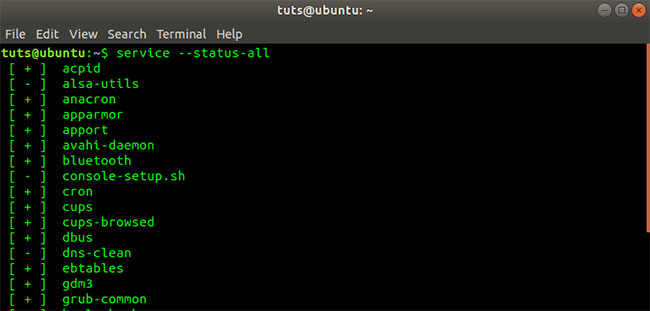 Service -status-all command output
Service -status-all command output The above command lists all the services running in the system. In case the service is running a lot, you can use the additional parameters - more and less to list the services in the view in an organized and clear manner.
service --status-all | less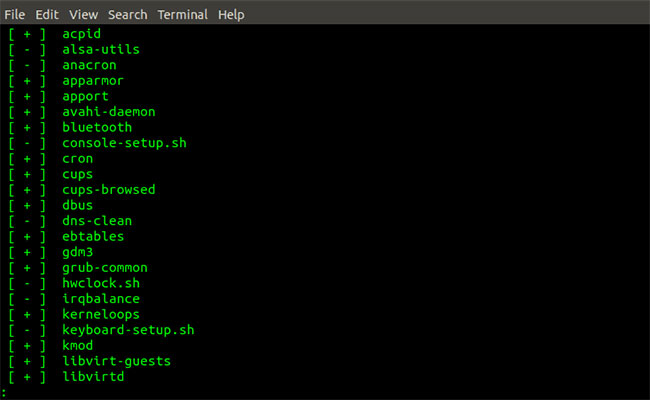 Service command output –status-all | Less
Service command output –status-all | Less service --status-all | more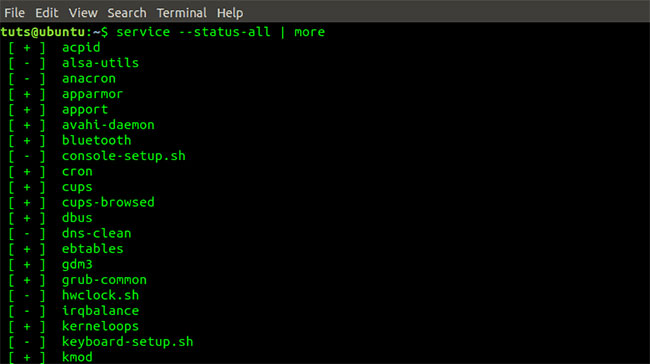 Service command output –status-all | More
Service command output –status-all | More To list only services currently running on the system, execute the command below:
service --status-all | grep runningTo view the status of a specific service, execute the command below:
service --status-all | grep [service_name] e.g service --status-all | grep httpdAlternatively, you can execute the below command to view the status of a specific service.
service httpd statusTo list all services that are activated during boot, execute the command below:
chkconfig --listCheck all services running in the Upstart init system
To list all services on Linux machines running the Upstart init system, execute the command below:
initctl listCheck all the services running in the Systemd init system
To list all services on Linux machines running Systemd init, execute the following command:
systemctl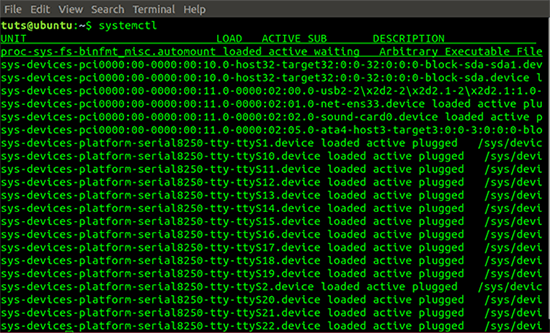 Systemctl command output
Systemctl command output From the above command, we see that the data is displayed in 5 columns, namely UNIT, LOAD, ACTIVE, SUB and DESCRIPTION .
You can also list running services based on their type with the following command:
systemctl list-units --type service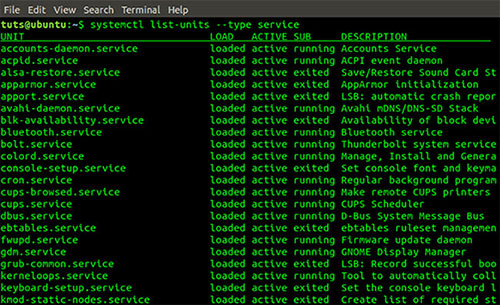 Output command systemctl list-units –type
Output command systemctl list-units –type You can also list services based on their current state. The result is quite similar to the output of the previous command but a bit simpler.
systemctl list-unit-files --type service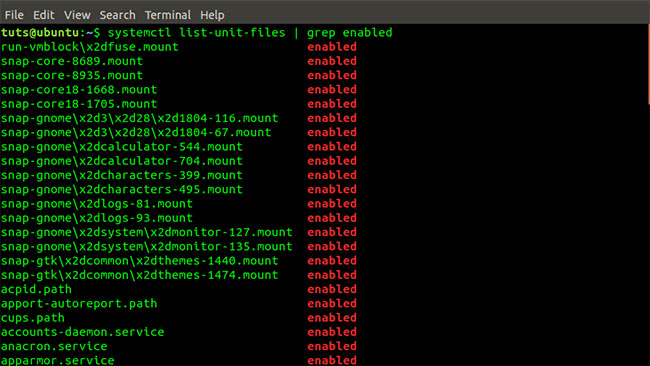 systemctl list-unit-files | grep enabled
systemctl list-unit-files | grep enabled To list the status of a specific service, execute the command below:
systemctl status [service_name] e.g systemctl status acpid.path Systemctl status acpid.path command
Systemctl status acpid.path command To list only services currently running on the system, execute the command below:
systemctl | grep running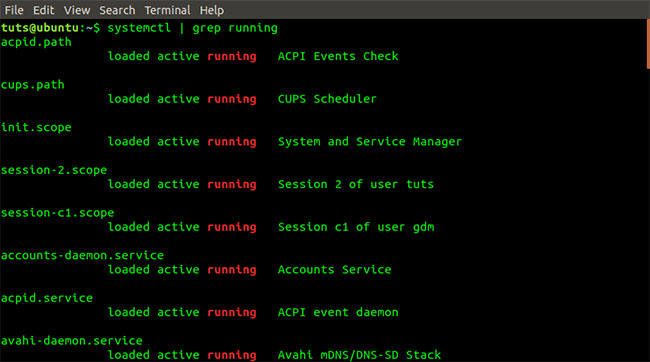 The systemctl command | grep running
The systemctl command | grep running To list all services that are activated during boot, execute the command below:
systemctl list-unit-files | grep enabled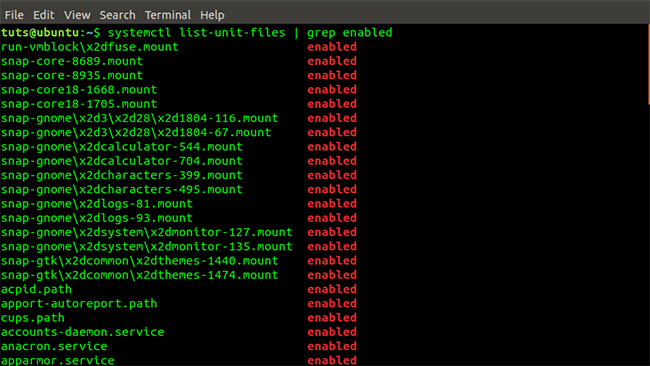 The command systemctl list-unit-files | grep enabled
The command systemctl list-unit-files | grep enabled You can also view the top control groups and their use of system resources such as I / O, CPU, Tasks and Memory using the systemd-cgtop command .
systemd-cgtop Systemd-cgtop command output
Systemd-cgtop command output It is also possible to use pstree to list all services running on the system. Pstree gets this information from the Systemd system output.
pstree Pstree command output
Pstree command output Pstree can also be used with the System V int system. It takes the output from the SysVinit system.
pstreeYou can also use the chkservice utility to check all the services running on the Systemd system. This utility is not preinstalled. However, you can install it via Terminal using the command below:
sudo apt-get install chkservice Chkservice installation command
Chkservice installation command To start the chkservice, execute the command below. Note, you need superuser rights.
sudo chkservice The command starts chkservice
The command starts chkservice To see all the features that come with this great tool, press the key ?to open the Help menu .
 Press ? to open the Help menu
Press ? to open the Help menuYou should read it
- Google blacklisted some web browsers on Linux, blocking access to Google services
- Basic Linux commands everyone needs to know
- 8 best Linux distros for pentest
- 14 interesting Linux commands in Terminal
- How to check the status of using laptop battery running Linux
- Why are Linux computers still important?
- How to access user activity on Linux
- How to check the time of shutdown and reboot in Linux
May be interested
- How to check the time of shutdown and reboot in Linux
 there are many reasons why you might want to find out when your linux computer is off, reboot or how long it will run. in most cases, this information is invaluable in debugging a problem.
there are many reasons why you might want to find out when your linux computer is off, reboot or how long it will run. in most cases, this information is invaluable in debugging a problem. - Check the current user on Linux
 in linux, you can perform simple tasks such as checking the current user in many ways. this tutorial will show you how to use some of the quickest and easiest ways to check users on linux.
in linux, you can perform simple tasks such as checking the current user in many ways. this tutorial will show you how to use some of the quickest and easiest ways to check users on linux. - Google blacklisted some web browsers on Linux, blocking access to Google services
 google has issued a notice banning a number of popular linux browsers from signing in to its services.
google has issued a notice banning a number of popular linux browsers from signing in to its services. - How to check the desktop environment you are using on Linux
 as you probably know, linux-based operating systems are heavily focused on the command line to perform operations. a minimal distro like arch linux will give you a dark terminal installation.
as you probably know, linux-based operating systems are heavily focused on the command line to perform operations. a minimal distro like arch linux will give you a dark terminal installation. - Instructions for using pstree command on Linux
 pstree is a powerful and useful command to display processes running in linux. like the ps command, it shows all the processes that are currently active on your login system. the main difference is that when running the pstree command, processes are organized into tree sorting instead of lists like using the ps command.
pstree is a powerful and useful command to display processes running in linux. like the ps command, it shows all the processes that are currently active on your login system. the main difference is that when running the pstree command, processes are organized into tree sorting instead of lists like using the ps command. - HOW TO INSTALL ISA SERVER ENTERPRISE 2000 - Part II
 one of the most important parts on isa server systems is to understand exactly what services are running on isa server, how these services work together, and with what types of isa clients. a simple diagram can be sketched as follows about the main services running on the isa server.
one of the most important parts on isa server systems is to understand exactly what services are running on isa server, how these services work together, and with what types of isa clients. a simple diagram can be sketched as follows about the main services running on the isa server. - How to check the pressure of a Linux system
 testing pressure on linux servers is a good idea if you want to see if they work well. in this post, tipsmake introduces some tools that can help you add pressure to the system to test and evaluate results.
testing pressure on linux servers is a good idea if you want to see if they work well. in this post, tipsmake introduces some tools that can help you add pressure to the system to test and evaluate results. - How to check and manage disk space in Linux
 a common problem is that updates fail due to a lack of disk space, but there are some simple tests that users can perform when they encounter an error message, to keep critical systems smooth operation.
a common problem is that updates fail due to a lack of disk space, but there are some simple tests that users can perform when they encounter an error message, to keep critical systems smooth operation. - How to Check IP Address on Linux
 this article shows you how to view the private and public ip addresses of computers using the linux operating system.
this article shows you how to view the private and public ip addresses of computers using the linux operating system. - 4 interfaces and Linux distros that can be run on PinePhone
 pine microsystems created pinephone. some mobile interfaces for linux support pinephone. that is very interesting, but it is important that you decide which option is right for you.
pine microsystems created pinephone. some mobile interfaces for linux support pinephone. that is very interesting, but it is important that you decide which option is right for you.










 How to install and optimize Minecraft on Linux
How to install and optimize Minecraft on Linux How to secure Linux server with fail2ban
How to secure Linux server with fail2ban Configure mouse settings on the Debian system
Configure mouse settings on the Debian system Differences between RHEL, CentOS and Fedora
Differences between RHEL, CentOS and Fedora How to install the latest LibreOffice version on CentOS 8
How to install the latest LibreOffice version on CentOS 8 How to use Lutris to play Blu-Ray on Linux
How to use Lutris to play Blu-Ray on Linux